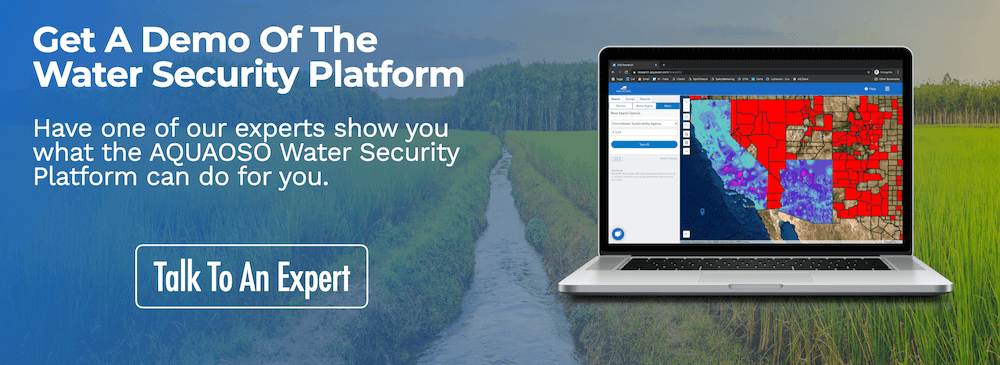4 Types of Transition Risk – Water and ESG Reporting
Much of the conversation around climate change focuses on environmental impacts, such as rising temperatures and extreme weather events. A big part of climate risk, however, involves transition risk – or the risk that results from changing policies, practices, and technologies that arise as societies work to decrease their reliance on carbon. As the Task Force on Climate-related Financial Disclosures puts it,
“Changes associated with a transition to a lower-carbon economy present significant risk, [but] they also create significant opportunities….. Organizations that invest in activities that may not be viable in the longer term may be less resilient to the transition.”
Those that take transition risk into account as part of a broader ESG initiative will be better prepared to mitigate these impacts.
When it comes to the agricultural sector, these transition risks include changing land-use policies, water conservation practices, ESG reporting requirements, and more. These trends are already underway, and ag professionals who fail to transition along with them will face increased risk.
This post will explore the current state of transition risk, particularly where it intersects with water risk and the growing importance of ESG reporting.
Transitioning to Water Resiliency
Water stress is not, in itself, a new phenomenon. In his book, “Water: The Epic Struggle for Wealth, Power, and Civilization,” Steven Solomon writes that despite technological advances, farming societies throughout history eventually have found that “their ability to exploit water no longer matches the demand they’ve created.”
The world is currently going through such a crisis, as climate change exacerbates existing water shortages and threatens the water supply of half the freshwater basins in the U.S.
The good news is that a transition to water resiliency is happening. This includes, but is not limited to, a combination of new groundwater protections, advanced water conservation technologies, support for impact investing and ESG initiatives, and a common recognition of the need for action.
The World Bank notes that: “Global entrepreneurs are witnessing a greater willingness by utilities and businesses to test and adopt promising technologies [such as] the remote sensing of water … [and] the Internet of Things, which enables smart irrigation [and] allows us to develop complex models for water management.”
Additionally, many states are revisiting their water conservation policies, whether it’s updating the Colorado River Compact or implementing the Sustainable Groundwater Management Act (SGMA) in California. Together, these trends are driving growers to adopt more water-resilient practices and lenders to perform more thorough water risk assessments before approving loans.
Ag professionals can expect to see even more focus on water-related transition risk in the years to come, as governments mandate standardized ESG disclosures and corporate decision-makers roll out water conservation strategies of their own.
Lenders and investors are already feeling pressure to adapt to these trends. It is crucial to acknowledge that although ESG reporting requirements are not fully solidified in the U.S. due to their nonlinear nature, the SEC has assigned a task force whose job will be to ensure quality, accurate ESG disclosures.
The time for agricultural finance institutions to implement strategies to reduce transition risk is now. If this process does not start with granular data, it is a shot in the dark.
Mitigating Water Risk as A Transition Risk
Water is one of the most impactful branches of the climate crisis, in part because it touches practically every industry and ecosystem. As a report by Columbia University Earth Institute explains, climate change “will put pressure on drinking water supplies, food production, property values, and more, in the U.S. and all around the world.”
For ag lenders and investors, water will be one of the most important transition risks to monitor. This includes assessing and mitigating water risk within their portfolios, as well as helping borrowers transition to more water resilient practices, such as regenerative farming. A failure to do so will present major business risks.
The Task Force on Climate-related Financial Disclosures identifies four key types of transition risk:
- Policy and Legal Risks
- Technology Risk
- Market Risk
- Reputation Risk
Policy and Legal Risks
Policies related to climate change and water risk are still in flux as different states roll out new regulations and reporting requirements. For example, a new Arizona law will allow farmers to conserve water without losing their rights to it, while SGMA requires California water users to adhere to strict groundwater pumping allocations.
The uncertainty surrounding these policies helps to explain why water risk is a business risk. In some cases, it’s the policies that are designed to reduce water stress that will have the most impact on farming operations. These policies may be designed to encourage water conservation or more sustainable water and land use. In some cases, regulations may limit actions that make the undesirable effects of climate change worse.
Organizations that don’t adapt to these policies could open themselves up to legal risk, especially in the context of climate-related disclosure. Failing to adapt portfolios to water risk, or failing to disclose these risks to regulatory parties, may result in increased litigation.
Identifying and monitoring these risks through data helps give the necessary foundation for mitigation strategies.
Technology Risk
Technology risk is closely linked with competitiveness. Some of the most important tools for conserving water in agriculture – such as field sensors and drip irrigation – require investment, while older systems and technologies will increasingly become obsolete.
New technologies include emerging digital data platforms like the Water Security Platform, which uses GIS data to assess water risk.
It is crucial to recognize that while investment in these new methods costs capital, the risks and pitfalls that will come from not adopting these technologies will be severe in the long term. Look to trends in climate change and water stress for a picture of what not adopting water resilience strategies can cause.
There’s no denying the fact that this transition phase will result in winners and losers, as some farming operations are able to implement these new technologies and others are not. Lenders who recognize the need to loan capital to borrowers so that they may make these transitions will be at an advantage amid a rising climate and dwindling water resources, with longevity and sustainability on their side.
The speed at which these tools are developed and applied may correlate with impacts to production costs and overall competitiveness throughout the transition period.
Market Risk
Market risks include everything from changes in supply and demand to increased costs for inputs such as water and energy. Water scarcity is expected to impact the market in complex ways, from increasing the cost of food commodities to incentivizing the use of wastewater in agriculture.
The value of farmland may also be impacted as some land will no longer be suitable for water-intensive crops.
While some of these impacts may be hard to predict, understanding the effect of water stress on the supply chain will be key to mitigating these transition risks.
Reputation Risk
Finally, there’s reputation risk, which relates to public perception of a company’s stance or behavior. Consumer preferences are increasingly being influenced by climate-related practices, and investors are shifting their money toward sustainable agriculture.
Companies that fail to embrace ESG initiatives or adopt water-saving technologies and practices are more likely to be viewed in a negative light.
Transition Risk and ESG Reporting
The throughline connecting all of these types of transition risk is data. Without the right data, lenders and investors can’t assess whether the farming operations they back will be impacted by new water restrictions or reporting requirements. Companies can’t be confident that their supply chains will be sustainable in light of market fluctuations, or changes in public sentiment.
Understanding how these risks come about involves more than just an analysis of financial capital. To be competitive in this changing landscape, companies need to identify the links between financial, social, and natural capital.
This stands to benefit both the growers on the ground and the ag banks that support them – both of whom are inextricably tied to the well-being of water. Better data can help to identify stranded assets due to water risk.
Ultimately, gathering this kind of data forms the basis of successful risk mitigation and accurate ESG reporting and compliance. Without reliable data, ag professionals could leave themselves vulnerable to all four types of transition risk.
Learn more about ESG reporting and capital risk in AQUAOSO’s explorable guide.
The Bottom Line
Transition risks are those that are caused by not responding to climate change and progressing the way businesses run. Policies and regulations, as well as societal expectations and market pressure to move towards more sustainable practices, will be major influencers.
In the agricultural sector, these risks can’t be separated from water risk, which underlies many impacts of climate change. New technologies can help to streamline this transition, but can also divide adopters from those who are slow to change.
AQUAOSO’s Water Security Platform purpose-built to help ag professionals identify and mitigate transition risks. From identifying watershed boundaries to looking up the water rights associated with a specific parcel of land, lenders and investors can perform due diligence for all of the properties in their portfolio with water resilience in mind.
Additionally, they’ll be ahead of the curve when it comes time to file ESG reports and disclose their resilience strategy to stakeholders.
Contact the AQUAOSO team today to start a conversation, or read the free guide to ESG reporting in agriculture to find out more.
Recent Posts
Sustainable Agriculture Practices That Need Financial Capital
In late 2021, world leaders gathered in Glasgow for COP26, better known as the UN’s climate change conference. With over 25,000 attendees meeting to discuss the efforts needed to address climate change, themes of sustainability, renewable energy and the reduction of...
2022 Sustainable Agriculture Trends for Ag Finance to Be Aware of
With real-world impacts like rising global temperatures, climate change is one of the biggest risk factors agriculture faces today. NOAA reported that 2020 was the second warmest year and the EPA explains a consistent increase of 0.16°F in average surface temperature...
Crucial Ways Agricultural Bank Services Can Contribute to A Sustainable Ag Economy
Ag banks and Farm Credits, enable agribusinesses to attain the financing they need in order to execute functions like harvesting and planting, as well as buying new equipment and combat overhead costs. They allow farmers to operate by engaging in a relationship with...






